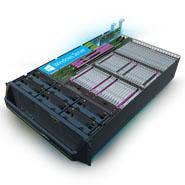Violin Memory Teams With Microsoft To Embed Windows Storage Server 2012 In All-Flash Array

Violin Memory Tuesday introduced what it called the first all-flash storage array with Windows Storage Server 2012 R2 embedded as a way to accelerate Windows-based applications while letting customers use the management tools they already have in play.
The new Windows Flash Array from Violin Memory is also the first all-flash storage array that was developed together with Microsoft, said Eric Herzog, chief marketing officer and senior vice president of business development for the storage vendor.
"With the Windows Flash Array, we're embedding a copy of Windows Storage Server 2012 R2 in the array," Herzog said. "We're the only company to do so. Microsoft wrote code in Windows Storage Server that recognizes the Violin flash memory, while we wrote code to communicate with the operating system. We're the only flash storage company that has jointly developed Windows Storage Server 2012 code."
[Related: Former EMC Exec Plots Course To Help Reset Violin Memory]
The ability to offer an all-flash storage array tuned specifically for Microsoft Windows environments is a huge differentiator for Violin Memory, said Jamie Shepard, regional and health systems senior vice president at Lumenate, a Dallas-based solution provider and Violin Memory channel partner.
"The people I'm selling to know Windows Server and know clustering," Shepard said. "Violin is going head-to-head with the Nutanixes and with the pure-play flash storage array vendors of the world."
Microsoft Server is a well-known and trusted operating system, Shepard added. "People know it for its ease of use," he said. "We know Microsoft will continue to develop the software. And this addresses a market need immediately. Do you know how many customers do Microsoft?"
Because of the collaboration between Violin Memory and Microsoft, Violin's new Windows Flash Array can take advantage of SMB Direct, which enables the array to directly load data into the application server's memory to increase the application's performance, Herzog said.
It also takes advantage of RDMA (remote direct memory access) to increase bandwidth and can use the operating system to provide high-speed file performance in NAS environments, he said. It uses Microsoft's clustering tools as well, he said.
As a result, the Windows Flash Array provides twice the Microsoft SQL write performance and increases SQL read performance by more than 50 percent compared with typical all-flash storage arrays, Herzog said. It also increases Microsoft Hyper-V writes by more than 40 percent, drops latency at load by 50 percent, and decreases application server CPU utilization by 30 percent.
NEXT: Violin Memory Focuses On Flash Storage Performance To Free App Server Performance
That drop in application server CPU utilization is huge, Herzog said. "Instead of an application server doing a bunch of storage functions, SMB Direct and RDMA push those functions to the storage array to free up the application server performance," he said.
Herzog said the enhanced performance are application-based numbers, not storage numbers. "Most CIOs are not storage experts," he said. "They want to know how fast the applications perform. These SQL and Hyper-V numbers resonate better with the app owners."
Violin Memory's Windows Flash Array is designed as a single device with two clustered blade servers running Windows Storage Server 2012 R2 as an active-active two-node cluster, Herzog said. Each array is configured with 64 TB of raw flash storage capacity.
"Sixty-four TB is becoming the most popular all-flash storage capacity," he said. "We're also looking at smaller capacity models in the future."
The Windows Flash Array scales to up to four arrays or eight server nodes in a single cluster with a total capacity of 256 TB of all-flash storage capacity that can be presented as a single large storage volume or carved up as needed, he said.
It also includes a 10-Gbit Ethernet network card that provides RDMA-enabled access over IP networks, giving it better performance at a lower cost than Fibre Channel, he said. A version with InfiniBand also is slated to ship in the near future, he said.
While the Windows Flash Array is optimized to run in Windows environments, it also can be run in non-Windows environments, Herzog said. However, that would require connecting to the array via iSCSI, which would result in performance basically the same as Violin Memory's current Violin Flash Array, as it would not be able to take advantage of the SMB Direct and RDMA capabilities, he said.
Shepard said one advantage of the Windows Flash Array not mentioned by Violin Memory is the fact that the new array means the vendor no longer is tied to Symantec.
"Violin has used Symantec replication technology, which adds to the cost while keeping control of the upgrades in Symantec's hands," Shepard said. "If Violin Memory builds in Windows Storage Server, they can use Microsoft tools instead. This is a huge deal for them. That makes them in charge of their own upgrades."
The Windows Flash Array is slated to ship this week with a list price of about $700,000 per array, which is about the same price as the company's Violin Flash Array, Herzog said.
PUBLISHED APRIL 22, 2014